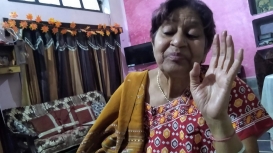Nautanki is a popular performance genre combining story, music, dance and dialogue. It started as an all-male form of musical entertainment in Hathras during the last quarter of the nineteenth century, but the theatrical dimensions of nautanki developed in the Kanpur region, from the early twentieth century onwards. From the 1930s, women joined as actors, and nautanki held sway as the most popular form of entertainment in North India. Troupes travelled to perform in villages and towns with entire families watching all-night shows.
Nautankis were often based on oral tradition, with kings, queens, lovers, bandits, saints, local heroes and heroines: Raja Harishchandra, Laila Majnu, Heer Ranjha, Puran Bhagat, Roop Basant, Indar Sabha, Amar Singh Rathore, and Sultana Daku were some of the immensely popular nautankis of the twentieth century.
While nautanki theatre functioned as a medium of entertainment, it was also a platform for ethical, political and social education. A wide range of nautankis during the 1920s, 30s, and 40s promoted resistance against the British regime, such as Rashtriya Saangit Julmi Dayar (on the Jallianwala massacre of 1919), Gandhi Haran, Shaheed Bhagat Singh, Jawahar Jeevan and Jhansi ki Rani Lakshmi Bai. Like the nautanki form itself, nautanki artistes drew from a mixed heritage and represented a plural culture; Hindus and Muslims, from diverse castes, coexisted, respecting each other’s beliefs and practices.
With the advent of cinema and television, nautanki faced enormous competition and could no longer hold its central position in the entertainment landscape. However, several artistes are attempting to reinvigorate the form. Nautanki plays are still performed with classical dramas as well as newer scripts, and have a devoted audience. The genre is uniquely suited to convey messages of contemporary relevance, including the promotion of a plural, secular culture.




